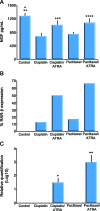Retinoic acid reduces chemotherapy-induced neuropathy in an animal model and patients with lung cancer
- PMID: 21865574
- PMCID: PMC3171957
- DOI: 10.1212/WNL.0b013e31822e045c
Retinoic acid reduces chemotherapy-induced neuropathy in an animal model and patients with lung cancer
Abstract
Objective: To evaluate the effect of all-trans retinoic acid (ATRA) as treatment for chemotherapy-induced peripheral neuropathy in an experimental animal model and in a randomized, double-blinded, controlled trial in patients with non-small-cell lung cancer (NSCLC).
Methods: Forty male Wistar rats were randomized in 5 groups: group A, control; groups B and C, treated with cisplatin; and groups D and E, treated with paclitaxel. ATRA (20 mg/kg PO) was administered for 15 days in groups C and E. We evaluated neuropathy and nerve regeneration-related morphologic changes in sciatic nerve, the concentration of nerve growth factor (NGF), and retinoic acid receptor (RAR)-α and RAR-β expression. In addition, 95 patients with NSCLC under chemotherapy treatment were randomized to either ATRA (20 mg/m(2)/d) or placebo. Serum NGF, neurophysiologic tests, and clinical neurotoxicity were assessed.
Results: The experimental animals developed neuropathy and axonal degeneration, associated with decreased NGF levels in peripheral nerves. Treatment with ATRA reversed sensorial changes and nerve morphology; this was associated with increased NGF levels and RAR-β expression. Patients treated with chemotherapy had clinical neuropathy and axonal loss assessed by neurophysiology, which was related to decreased NGF levels. ATRA reduced axonal degeneration demonstrated by nerve conduction velocity and clinical manifestations of neuropathy grades ≥2.
Conclusions: ATRA reduced chemotherapy-induced experimental neuropathy, increased NGF levels, and induced RAR-β expression in nerve. In patients, reduction of NGF in serum was associated with the severity of neuropathy; ATRA treatment reduced the electrophysiologic alterations.
Classification of evidence: This study provides Class II evidence that ATRA improves nerve conduction in patients with chemotherapy-induced peripheral neuropathy.
Figures



References
-
- Higgins MJ, Ettinger DS. Chemotherapy for lung cancer: the state of the art in 2009. Expert Rev Anticancer Ther 2009;9:1365–1378 - PubMed
-
- Quasthoff S, Hartung HP. Chemotherapy-induced peripheral neuropathy. J Neurol 2002;249:9–17 - PubMed
-
- Arrieta O, Michel Ortega RM, Villanueva-Rodriguez G, et al. Association of nutritional status and serum albumin levels with development of toxicity in patients with advanced non-small cell lung cancer treated with paclitaxel-cisplatin chemotherapy: a prospective study. BMC Cancer 2010;10:50. - PMC - PubMed
-
- Strumberg D, Brugge S, Korn MW, et al. Evaluation of long-term toxicity in patients after cisplatin-based chemotherapy for non-seminomatous testicular cancer. Ann Oncol 2002;13:229–236 - PubMed
-
- Zhong D, Zhang D, Song Y. The role of all-trans-retinoic acid on the proliferation and differentiation of rat embryonic neural stem cells. Chin J Reparative Reconstruct Surg 2008;22:206–211 - PubMed
Publication types
MeSH terms
Substances
LinkOut - more resources
Full Text Sources
Medical
Research Materials
